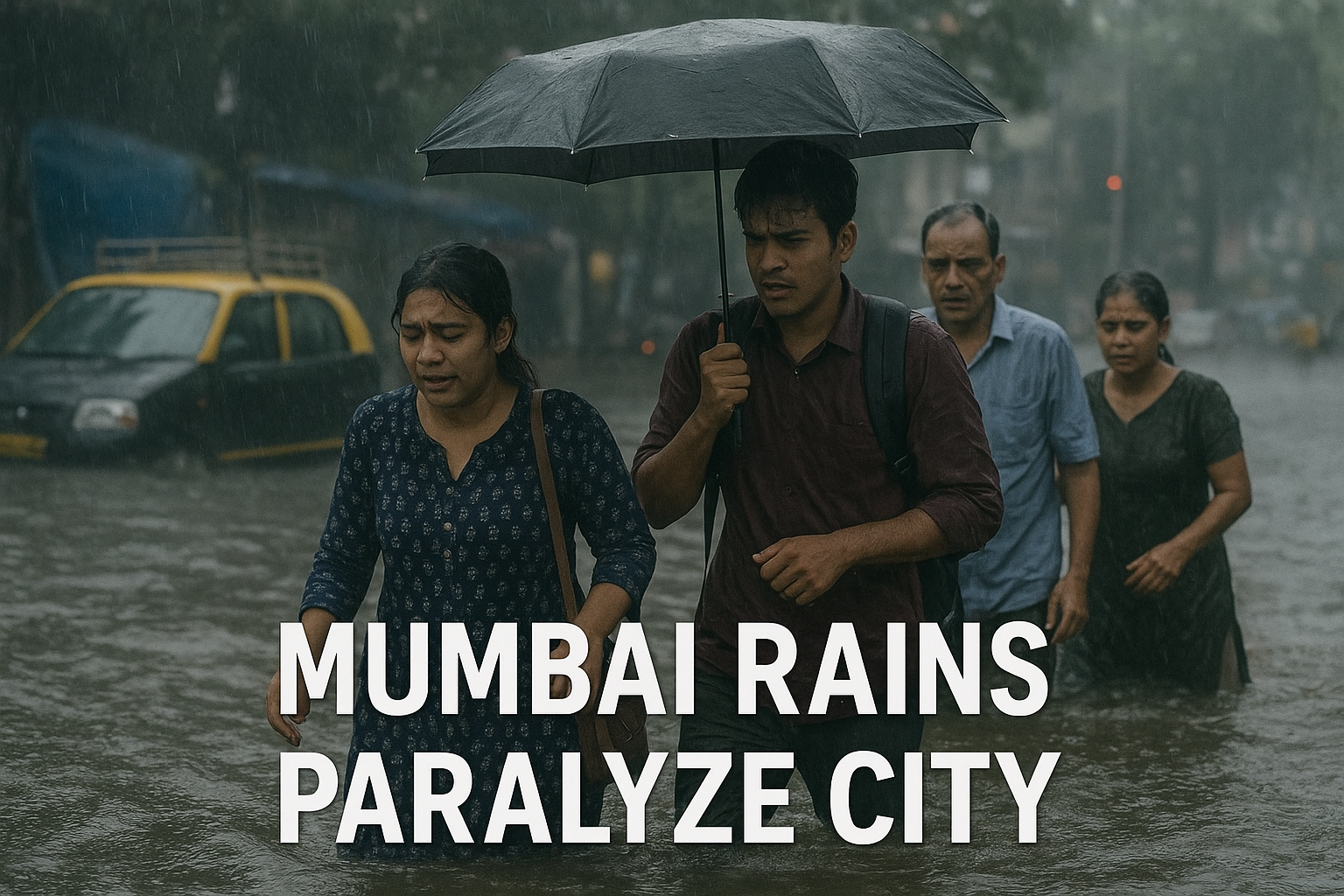Mumbai, August 19, 2025: For three consecutive days, Mumbai has been battered by relentless monsoon rains that have brought India’s financial capital to a standstill. On Monday, August 18, the city witnessed some of the heaviest rainfall of this season, leading the India Meteorological Department (IMD) to issue a “Red Alert” across the region. Schools and colleges were ordered shut, offices struggled with absenteeism, and daily commuters faced a nightmare as waterlogging and traffic chaos gripped the city.
Record Rainfall in 24 Hours
The numbers tell a dramatic story. Several parts of Mumbai recorded over 100 mm of rain in just 24 hours. Dahisar topped the charts with 188 mm, followed by Kandivali (150 mm), Vikhroli (135 mm), Chembur (124 mm), while Santacruz and Juhu reported 123 mm each. These staggering figures underline the intensity of Mumbai’s rain fury, making it one of the wettest spells of the year so far.
Schools in Confusion, Parents in Panic
What caught many families off guard was the last-minute decision by the Brihanmumbai Municipal Corporation (BMC) to declare a half-day holiday for schools and colleges. While the order was intended to ensure student safety, many institutions received the notification late, leaving students stranded in flooded streets and parents scrambling to arrange pickups.
In Matunga, a school bus was stuck in waist-deep water. Local police and volunteers formed human chains to rescue the children and guide them to safety. Stories like these not only highlight the risks children face in extreme weather but also reflect the spirit of quick response and human compassion.
Public Transport in Disarray
Mumbai’s lifeline — its local trains — was heavily disrupted as water levels rose above tracks in several areas. Many trains were delayed or canceled, stranding thousands of commuters. On the roads, the situation was no better. The Western Express Highway, one of the busiest arteries, turned into a slow-moving river of vehicles. Office-goers, delivery workers, and daily wage earners alike were caught in long traffic snarls.
For many, the choice was stark: either brave knee-deep waters to reach their destinations or return home and lose a day’s wages.
Alerts and Technology to the Rescue
On the brighter side, the IMD’s color-coded alert system (Red, Orange, Yellow) proved vital in informing citizens about the severity of the situation. For Tuesday, the forecast shifted to Orange and Yellow alerts, signaling slightly reduced intensity but still urging caution.
Adding to preparedness, IIT-Bombay in collaboration with IMD has rolled out hyperlocal rain and flood alerts that update every 15 minutes. This initiative, delivered via mobile notifications and online dashboards, is already helping citizens make informed decisions about travel and safety.
Humanity Amid Hardship
Even as the rain disrupted lives, it also brought forward acts of kindness and responsibility. Bollywood actor Harshvardhan Rane used his social media to send out a heartfelt appeal:
“Please avoid ordering food from outside today. Delivery workers are also struggling in these conditions. Let’s cook at home and ease their burden.”
Such appeals struck a chord with many Mumbaikars, reminding them that small personal sacrifices can make a big difference for those on the frontline during extreme weather.
The Bigger Picture: Mumbai’s Urban Challenge
Experts point out that these events are not just about a single day’s rainfall but part of a larger urban and climate challenge. Rapid urbanization, inadequate drainage systems, and the shrinking of natural water-absorbing areas like wetlands and mangroves have made Mumbai increasingly vulnerable to flooding.
The city’s monsoon story is no longer just about inconvenience — it is about climate resilience. Each season reveals the cracks in infrastructure and governance. Without significant long-term investments in urban planning, Mumbai risks repeating this cycle year after year.
Lessons from the Deluge
This week’s rains have offered both warnings and insights:
- Emergency Alerts Matter: Timely warnings from IMD saved lives, but sudden last-minute decisions — like school closures — created chaos. Clearer communication is vital.
- Infrastructure Needs Urgent Attention: Waterlogging on highways and train tracks shows that Mumbai’s drainage systems are struggling to cope with extreme rainfall.
- Community Spirit is Key: From police forming human chains to citizens helping strangers, the resilience of Mumbaikars continues to shine through.
- Technology Can Empower: Hyperlocal rain alerts and AI-based flood prediction tools are game changers — but their reach must expand to all citizens, especially those without smartphones.
A City Tested, A City That Endures
Mumbai’s relationship with the monsoon is one of love and fear. The rains bring relief from summer heat, but they also expose the fragility of urban life in a megacity. This week, the downpour has tested every aspect of Mumbai — its infrastructure, its administration, and its people.
Yet, as always, the city endures. The sight of strangers sharing umbrellas, shopkeepers offering tea to stranded commuters, and volunteers guiding children to safety is a reminder that while rain may flood the streets, it cannot wash away Mumbai’s spirit.
In Conclusion
The heavy rains of August 2025 are more than just a seasonal disruption. They are a wake-up call for a city that prides itself on resilience but urgently needs smarter infrastructure, better communication systems, and stronger climate action plans.
Until then, Mumbaikars will continue to adapt, adjust, and endure — one flooded street, one disrupted train, and one shared act of kindness at a time.

